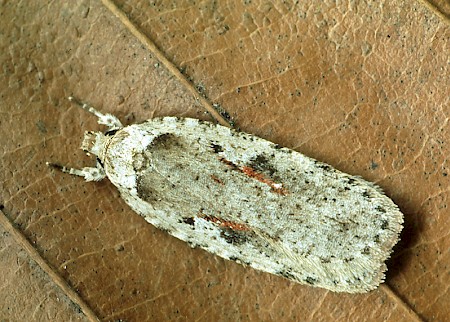32.007 BF701
Agonopterix ocellana
(Fabricius, 1775)
Wingspan 19-22 mm.
Relatively common throughout the British Isles, this fairly distinctive Agonopterix overwinters as an adult, often being found in early spring as it awakes from hibernation.
The larva feeds on various willows (Salix spp.), feeding between leaves spun together with silk.
The species is easily identified by the combination of rufous, black and white in the centre of the forewing.
- Larva: (description Ian F. Smith):
Foodplants: June - July in spun leaves or rolled leaf of Salix spp.
Early instar larva
Length: 10 mm described.
Head: Pale brown. Strong pitchy black postero-lateral spot. Stemmata linked by pale grey 'c' shape mark.
Prothoracic shield: Pale greenish brown. Sometimes with dark postero-lateral marks. Black posterior and lateral pinacula.
Thoracic legs: Translucent pale brown.
Body: Pale translucent greenish. Paler ventrally.
Spiracles: Peritreme black.
Pinacula: Black, except concolorous with anal plate on segment A10. Segments A1,2,7,8 have a single row of four black pinacula on venter.
Setae: Colourless transparent.
Anal plate: Concolorous. Anteriorally a medial double row of transparent dots that diverge laterally at 90 degrees near the mid point of the anal plate.
Prolegs: Transparent. Concolorous with venter.Late instar larva
Length: 17 mm described.
Head: Pale brownish green. Frons more greenish. Faint brown postero-lateral spot. Stemmata linked by pale grey 'c' shape mark (indistinct in photograph).
Prothoracic shield: Green with black pinacula.
Thoracic legs: Translucent very pale greenish brown.
Body: Apple green, paler ventrally. Dark contractile vessel visible dorsally. Indistinct dark subdorsal line. Prepupation dorsal cuticle tinted purple-red, strongest intersegmentally, ventrally jade green.
Spiracles: Peritreme black.
Pinacula: Black, except concolorous with anal plate on segment A10. Segments A1,2,7,8 have a single row of four black pinacula on venter.
Setae: Light brown, translucent.
Anal plate: Green. Irregular pattern of transparent dots show darker.
Prolegs: Translucent. Concolorous with venter. Crotchets pale brown.

 UKMoths
UKMoths 






